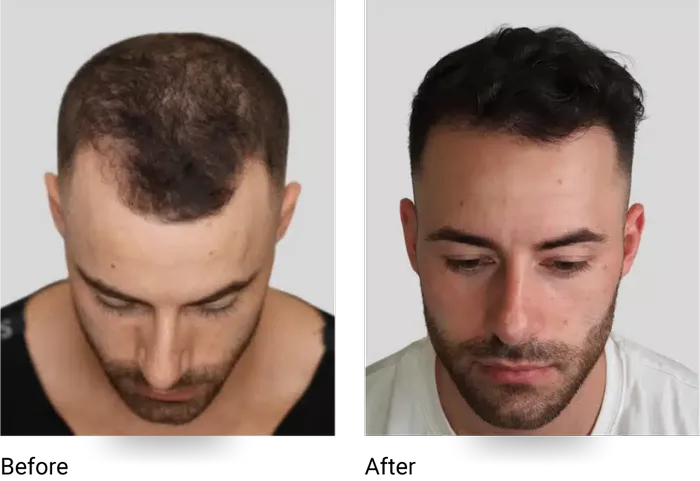Beard hair transplant, a specialized form of hair transplantation, has gained popularity among men seeking to enhance their facial hair density and achieve a fuller, more defined beard or mustache. Unlike traditional hair transplants that focus on scalp hair restoration, beard transplants target the facial region, including the beard, mustache, and sideburns. This procedure involves harvesting hair follicles from the donor area of the beard, usually the chin or cheeks, and implanting them into the desired areas of the face.
Advantages (Pros) of Using Beard Hair
1. Thicker Hair Shaft: One of the primary advantages of using beard hair for transplantation is its thicker hair shaft. Beard hair tends to be coarser and thicker than scalp hair, which can create a more robust and fuller appearance in the transplanted areas. This characteristic is particularly beneficial for individuals with naturally thin or sparse facial hair.
2. Preserving Scalp Donor Hair: By utilizing beard hair as a donor source, surgeons can preserve precious scalp donor hair for critical areas such as the frontal hairline and eyebrows. This strategic allocation of donor hair ensures a more natural and balanced aesthetic outcome, as scalp hair is typically finer and softer than beard hair.
3. Facial Hair Removal: For some men, facial hair can be undesirable, either due to genetics or personal preference. Beard hair transplantation offers a solution for individuals who wish to remove facial hair permanently while maintaining the option to cultivate a full beard or mustache through transplantation.
4. Similar Characteristics: When transplanted skillfully by an experienced surgeon, beard hair mimics the natural growth pattern and characteristics of existing facial hair. This includes matching the angle, direction, and density of the surrounding beard hair, resulting in a seamless integration with minimal discernible differences in texture or color.
Considerations and Limitations (Cons)
1. Limited Availability: One of the primary limitations of beard hair transplantation is the availability of suitable donor hair. Not all men possess adequate beard hair for transplantation, particularly those with sparse or patchy facial hair growth. Candidates must undergo a thorough evaluation by a qualified surgeon to determine the feasibility of the procedure based on their individual hair characteristics and donor supply.
2. Cost: Facial hair restoration procedures, including beard transplants, tend to be more expensive than traditional scalp hair transplants. The increased cost is primarily attributed to the specialized expertise required to perform facial hair transplantation and the meticulous nature of the procedure. Additionally, the limited availability of suitable donor hair may necessitate multiple sessions to achieve optimal results, further contributing to the overall expense.
3. Redness: Following beard transplantation, patients may experience temporary redness and inflammation in the donor and recipient areas. This post-operative redness typically resolves within a few weeks but can persist for longer in some cases. Patients should be prepared for this potential side effect and follow their surgeon’s instructions for post-operative care to minimize discomfort and expedite healing.
4. Scarring: Like any surgical procedure, beard transplantation carries a risk of scarring, particularly in the donor area where hair follicles are harvested. While modern techniques aim to minimize visible scarring, some individuals may still experience noticeable scarring depending on factors such as skin type, healing ability, and surgical technique. Patients should discuss the risk of scarring with their surgeon and ensure they understand the potential implications before undergoing the procedure.
In conclusion, beard hair transplantation offers a viable solution for men seeking to enhance their facial hair density and achieve a fuller, more defined beard or mustache. Despite its advantages, including thicker hair shafts and the ability to preserve scalp donor hair, candidates should carefully consider the limitations and potential drawbacks associated with the procedure, such as limited availability of donor hair, increased cost, temporary redness, and the risk of scarring. By consulting with a qualified and experienced surgeon, patients can make informed decisions and achieve natural-looking results that align with their aesthetic goals.
FAQs
What hair is not suitable for hair transplant?
Not all hair is suitable for hair transplant procedures. Hair that is very fine or wispy may not provide adequate coverage or density. Additionally, hair with a high likelihood of miniaturization, such as hair from the temples or crown of the head in cases of male pattern baldness, may not yield satisfactory results. It’s essential to consult with a qualified hair transplant surgeon to determine if your hair is suitable for transplantation.
Can you use any hair for hair transplant?
While the most common source of donor hair for hair transplants is the back and sides of the scalp, known as the donor area, not all hair is suitable for transplantation. The hair in the donor area is typically resistant to balding and maintains its thickness and growth patterns even when transplanted to other areas.
Can I use chest hair for hair transplant?
Chest hair is not typically used for hair transplant procedures due to several reasons. Chest hair tends to have a different texture and growth pattern compared to scalp hair, which may result in an unnatural appearance when transplanted to the scalp. Additionally, chest hair follicles may not have the same longevity or resistance to miniaturization as scalp hair follicles.
Can I use armpit hair for hair transplant?
Armpit hair is not suitable for hair transplant procedures for similar reasons to chest hair. The texture and growth pattern of armpit hair differ significantly from scalp hair, which can lead to an unnatural appearance after transplantation. Additionally, armpit hair follicles may not have the same characteristics of longevity and resistance to miniaturization as scalp hair follicles, making them less suitable for transplantation. It’s crucial to consult with a qualified hair transplant surgeon to determine the best donor hair options for your specific case.


